2. Position the upper main bearing shells in the crankcase so that the tabs fit into the recesses. Lubricate the bearing shells (photo). If old bushings are used, make sure they are installed in their original positions.

3. Lower the crankshaft into the crankcase.
4. Position the lower main bearing shells in the caps, #1, #2, and #5 caps are solid, and #4 caps are oil grooved. Bearing shell No. 3 is also solid, but the repair one contains a thrust flange (photo).

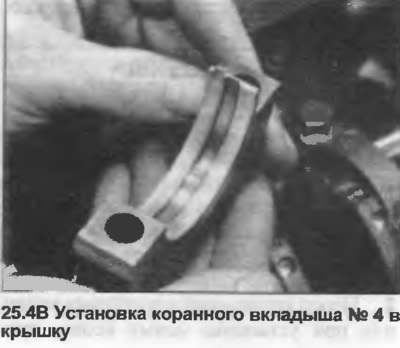
5. Place thrust washers on each side of #3 cover, using lubricant to secure them (photo). Make sure the oil grooves are facing out.
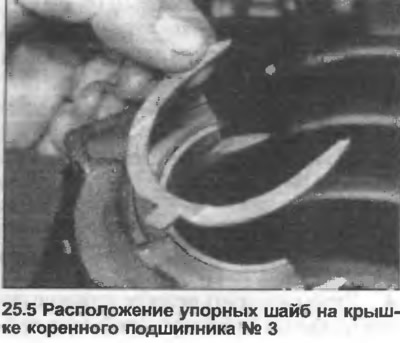
6. Lubricate the bearing shell, then install the No. 3 main bearing cap, insert the bolts and tighten them with the torque specified in the Specification.
7. Using a feeler gauge (photo 9.60) or micrometer, check that the side play matches the data in the Specifications (photo).
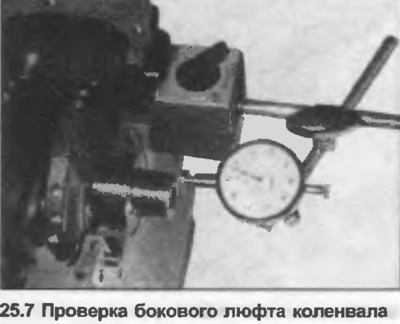
8. Lubricate the remaining liners of main bearings, then install the covers, insert the bolts and tighten them with the tightening torque regulated by the Specification (photo).
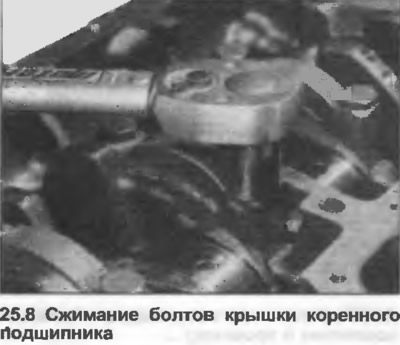
9. Check that the crankshaft rotates freely.
10. Lay the block on its side, rotate the crankshaft so that the neck of the connecting rod No. 1 is at BDC.
11. Position the bushing in the connecting rod so that the protrusion fits into the notch (photo). Lubricate the bearing shell.
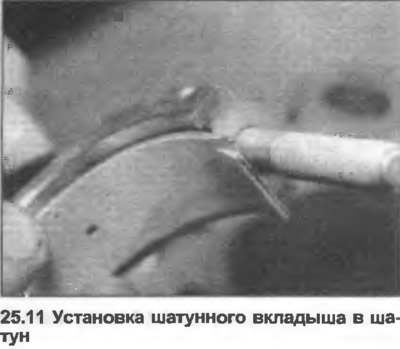
12. Position the piston ring cuts 120°apart. Liberally lubricate the rings and grooves, install the piston ring remover on the piston.
13. Lubricate the cylinder bore, then insert the piston and connecting rod, arrow on the piston head towards the front end of the engine.
14. Using a hammer handle, gently hammer the piston through the compressor into the cylinder bore, directing the connecting rod to the crankshaft journal (photo).
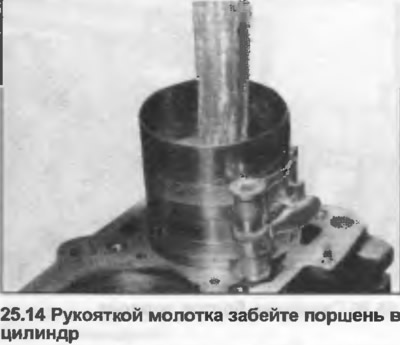
15. Position the connecting rod bushing in the connecting rod cap. Lubricate the bearing shell.
16. Install the bottom cover of the connecting rod with the insert on the racks, then lubricate the contact surfaces and install the nuts. Tighten the nuts first with the tightening torque specified in the Specification, then tighten them by an angle of 90° (photo). Make sure the lid is correctly oriented.
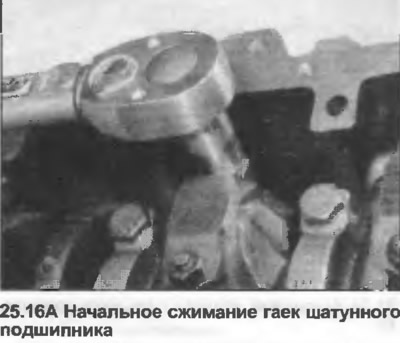
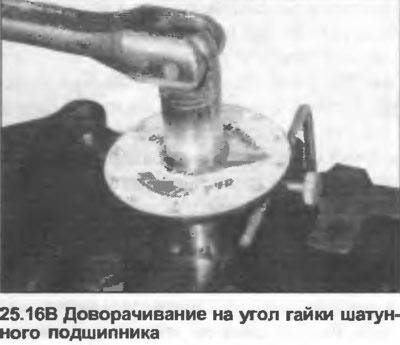
17. Repeat the procedure given in steps 10-16 for the remaining piston and connecting rod assemblies.
18. Temporarily insert two bolts into the rear of the crankshaft, rotate the engine to check if the crankshaft rotates easily.
19. Install the oil pump in the block, insert the mounting bolts and tighten them with the tightening force regulated by the Specification (photo).
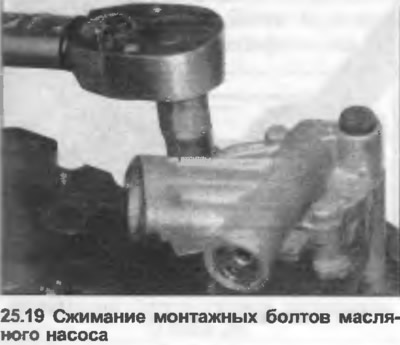
20. Position a new O-ring on the end of the suction tube. Install the tube on the oil pump, insert the bolts and tighten them with the tightening force regulated by the Specification (photo).
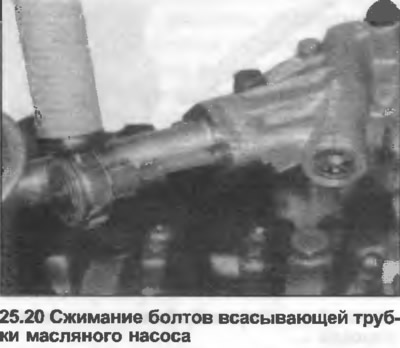
21. Install the crankshaft front oil seal housing (without gland), along with a new gasket. Insert and tighten the bolts with the tightening torque specified in the Specification (photo).
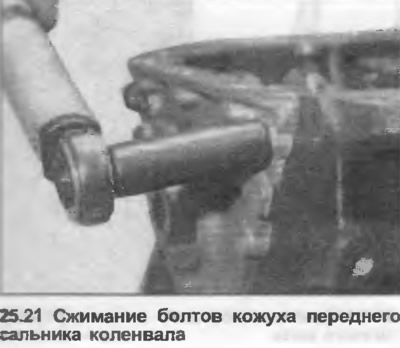
22. Lubricate the oil seal tabs and the outer frame of the new seat. Position the oil seal on the nose of the crankshaft. Using a suitable socket and mallet, drive the gland straight into the casing until it lines up with the outer edge (photo).
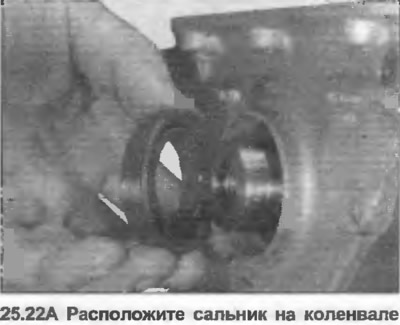
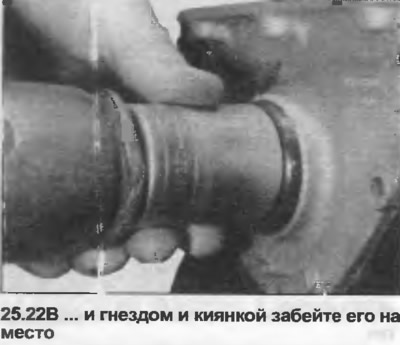
23. Install the crankshaft rear oil seal housing (without gland) along with a new gasket. Insert and tighten the bolts with a tightening torque specified specification (photo).
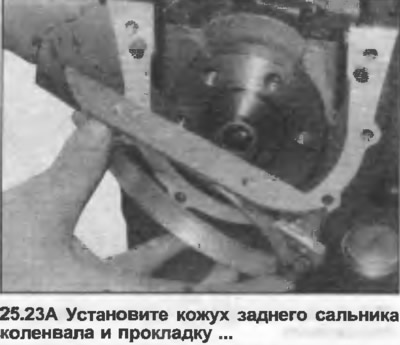
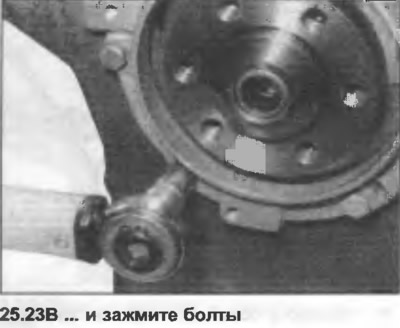
24. Lubricate the seal tabs and the outer rim of the new seal. Position the oil seal on the rear flange of the crankshaft (photo), gently tap it straight into the casing until it lines up with the outer edge.
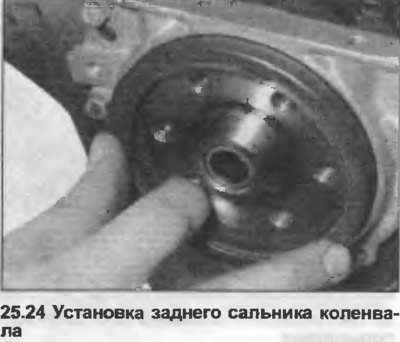
25. Turn the engine over, position the new gasket on the base of the block.
26. Install the pallet, then insert and tighten the bolts in a diagonal sequence with the tightening torque regulated by the Specification (photo).
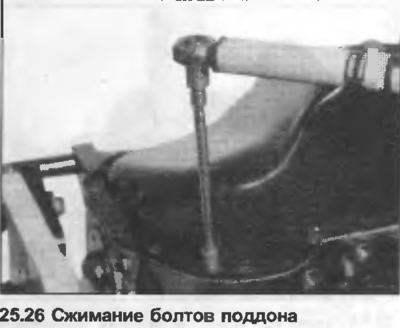
27. Support the engine in a standing position.
28. Apply a suitable insulator to the outer surface of the lower end of the dipstick tube. Hammer the dipstick tube into the block with a mallet.
29. Install the sprocket at the front end of the crankshaft.
30. Lubricate the threads of the bolt, then insert and tighten it with the tightening torque specified in the Specification (photo). Block the crankshaft in compression with a long rod placed between the two bolts at the rear of the crankshaft.

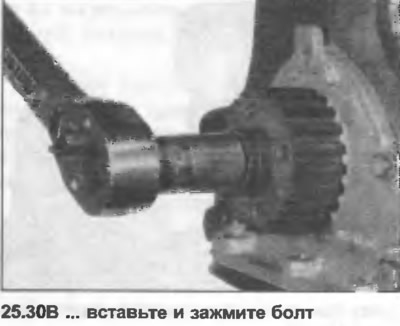
31. Lubricate the bearing journals on the intermediate shaft. Carefully insert the shaft into the block.
32. Lubricate the seal tabs and the outer rim of the new intermediate shaft oil seal. Place the seal flange on the bench, hammer the seal into place with a socket and a mallet (photo).
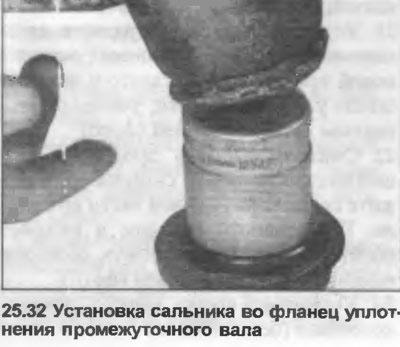
33. Position the new O-ring on the flange. Attach the flange to the block, insert the bolts and tighten with the tightening force regulated by the Specification (photo).
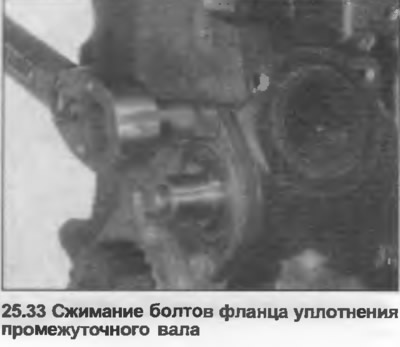
34. Check with a micrometer that the side play of the intermediate shaft matches the data in the Specifications (photo).

35. Install the right suspension of the engine mount bracket and the rod to the block, insert the bolts and tighten with the tightening force regulated specification.
36. Install the left suspension of the engine mounting bracket to the block, insert the bolts and tighten with a tightening force regulated specification.
37. Install the generator mounting bracket, insert and tighten the bolts.
38. Check that the top of the block is perfectly clean, then place a new gasket on it with the words 'OBEN TOP' facing up. Make sure the location pins are in place (photo).
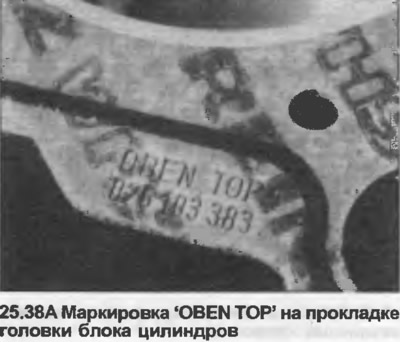
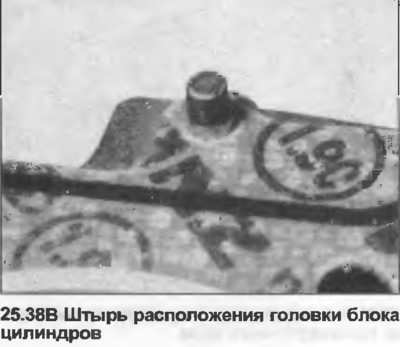
39. Rotate the engine clockwise until all pistons are in the middle of the bores, pistons #1 and #4 on the compression stroke. Inject oil into each cylinder (photo).
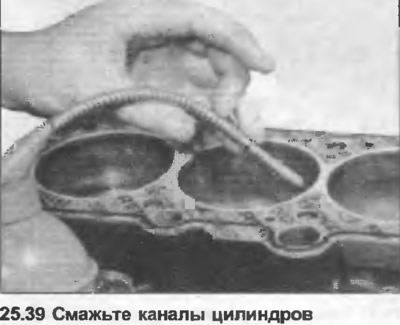
40. Check up, that the surface of a head of the block of cylinders was absolutely pure. Gently lower the head onto the block. Do not use any compounds when connecting the cylinder head.
41. Insert the cylinder head bolts together with washers, initially tighten them by hand.
42. In the sequence shown in Fig. 1.9, tighten the bolts to the torque of stage 1 given in Specifications. Then tighten them to the stage 2 torque, and finally tighten them half a turn (180°) endless (allowed twice 90°) (photo).
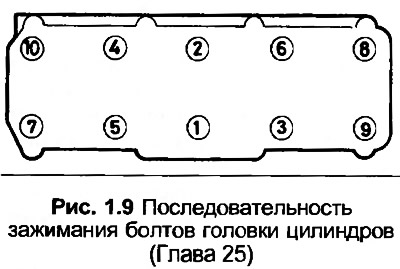
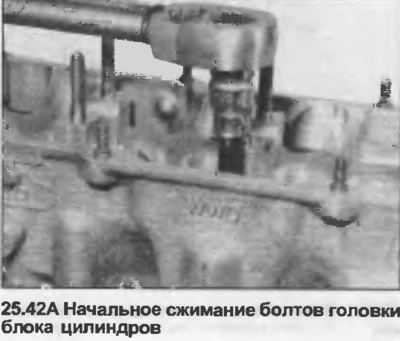
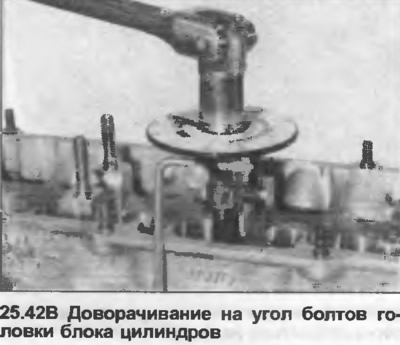
43. Install the engine front lifting eye, tighten the bolt.
44. Establish a back covering of a gear belt of a drive, insert and tighten bolts.
45. Rotate the intermediate shaft so that the keyway is facing straight up. Insert the key into the groove.
46. Install the sprocket on the intermediate shaft, hooking it with the segment key. Insert and tighten the bolt with a tightening torque specified specification. Block the sprocket with a tool made as shown in the photo.
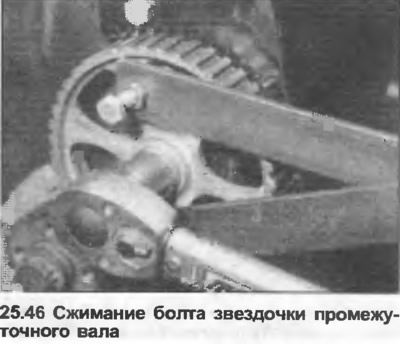
47. If necessary, before installing the hydraulic tappets, check the side play of the camshaft. To do this, follow steps 49 and 50, then check with a micrometer that the side play matches the data in the Specifications. Remove the camshaft again and continue with the next step.
48. Lubricate the hydraulic tappets, then insert them into the previously marked positions.
49. Lubricate the bearing journals on the camshaft, then lower the camshaft into place on the pushrods, making sure the cams for cylinder #1 point up.
50. Install bearing caps #2 and #5 (No. 4 skip). Install and tighten the nuts with a tightening torque specified specification (photo). Make sure the covers are oriented correctly as noted when removed because they are slightly offset.
51. Install the bearing caps No. 1 and 3, install and tighten the nuts with the tightening torque specified specification.
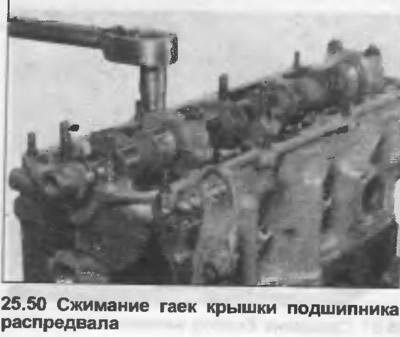
52. Lubricate the gland lugs and outer bezel. Position the oil seal on the front end of the camshaft, hammer it straight into place with a socket and a mallet, until it is aligned with the surface of the cylinder head (photo).
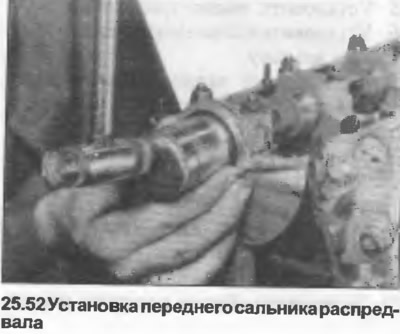
53. Insert the segment key into the camshaft groove. Position the sprocket on the camshaft, insert the bolt and washer, tighten the bolt to specification torque, locking the sprocket with a tool as shown in the photo or similar.
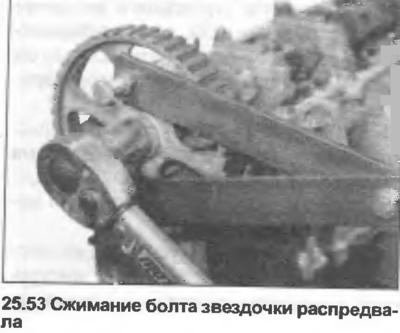
54. Install the drive belt tensioner wheel and hub onto the strut at the front end of the cylinder head, then install the washer and nut.
55. Temporarily install the drive belt pulley on the crankshaft sprocket in the previously marked position. Insert and tighten two diagonally opposite bolts.
56. Align the mark on the back of the camshaft sprocket with the top of the cylinder head on the left side.
57. Rotate the intermediate shaft sprocket until the mark lines up with the drive belt pulley. Rotate the engine clockwise until the mark on the pulley lines up with the mark on the sprocket (photo).
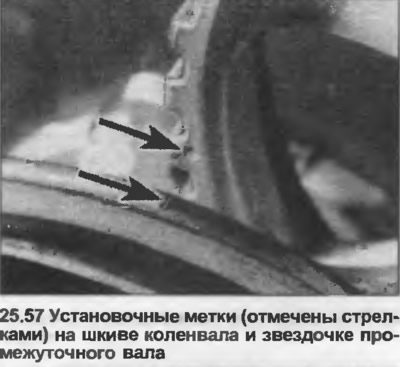
58. Position the timing belt on the crankshaft sprocket and countershaft sprocket, if an old belt is being installed, make sure it is correctly oriented to the previously made mark (photo).
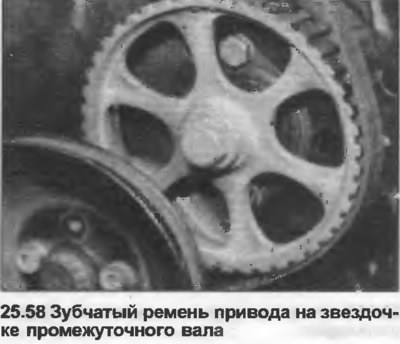
59. Install the belt on the camshaft sprocket, then on the tensioner wheel and turn the hub clockwise, locking the belt in position (photo).
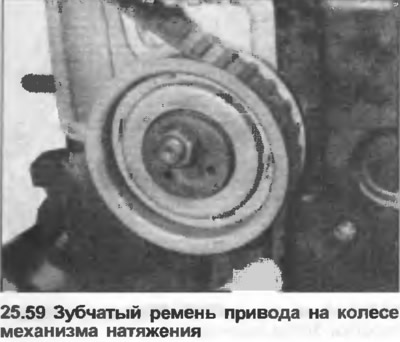
60. Using snap ring pliers or a suitable tool, turn the tensioner hub clockwise. Continue turning until the belt is tight enough that it can only be twisted 90°at a point midway between the countershaft and camshaft sprockets. Tighten the tensioner nut, check the tension and alignment marks again (photo).
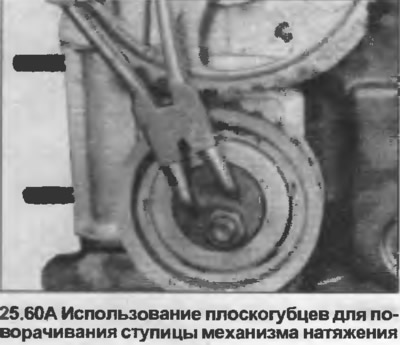
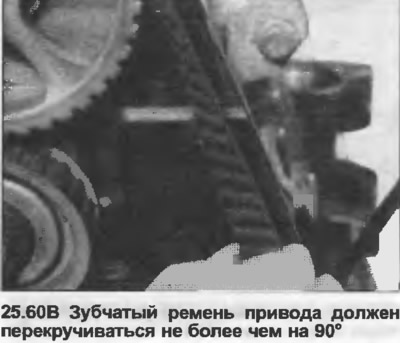

61. Unscrew the water pump pulley from the crankshaft sprocket. Position the special spacer in the lower drive timing belt cover, then install the cover, insert and tighten the bolts (photo).

62.Mount the water pump pulley on the crankshaft sprocket to the previously marked position. Insert and tighten the bolts.
63. Install the rubber plug on the back of the cylinder head, and the semi-circular gasket in the groove in the front camshaft bearing cap.
64. Install a new gasket on the racks on top of the cylinder head.
65. Install the oil deflector.
66. Install reinforcement strips and valve cover.
67. Position the ground clamp and wire straps. Tighten nuts.
68. Install the timing belt rear top cover. Tighten nuts.
69. Install the drive top cover and nut (where used). Fasten with staples.
70. Install the water pump assembly with a new O-ring. Insert and tighten the bolts.
71. Install the special bolt that secures the lower cover of the drive to the water pump assembly, tighten the nut.
72. Install the pulley on the water pump. Insert and tighten the bolts.
73. Install the outlet casing on the back of the cylinder head along with a new O-ring. Insert and tighten the bolts.
74. Establish an output branch pipe on a side of a head of the block of cylinders together with a new ring consolidation. Insert and tighten the bolts.
75. Install the oil filter housing on the block along with a new gasket. Insert and tighten the bolts.
76. Clean the mating surfaces of the new oil filter and housing, then lubricate the filter seal. Screw the filter into the housing, tighten by hand.
77. Install the fuel container and hanger on the valve cover. Tighten nuts.
78. Make sure the pins are on the back of the block. Install the intermediate plate on the pins.
79. Position the flywheel/drive plate on the crankshaft. Audi recommends always replacing the flywheel/drive plate bolts after removal. Apply locking fluid to the threads, then insert and tighten the bolts to the specified torque specification, by locking the flywheel/drive plate. Install the bolt in the cylinder block and secure the flywheel/drive plate with a screwdriver behind the ring gear. You can also use the tool shown in the photo. Check that the pre-made marks are aligned.



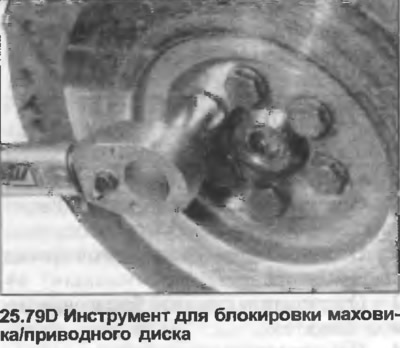
80. If at least one hydraulic tappet has been replaced, do not start or crank the engine for at least the next thirty minutes. This is necessary so that excess oil flows out of the pusher. If this precaution is not observed, there is a danger of the valve hitting the piston.

Visitor comments